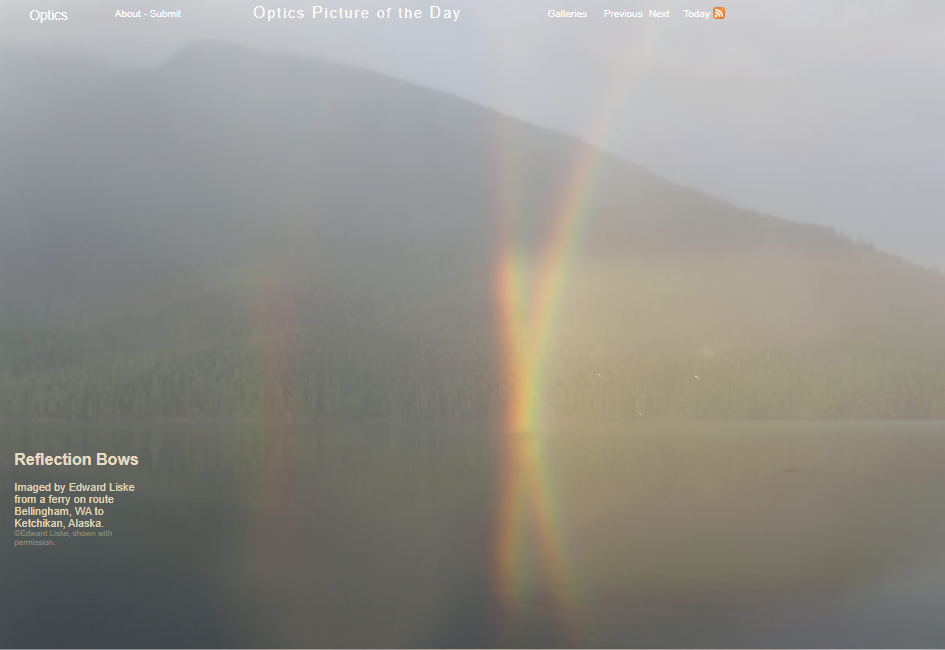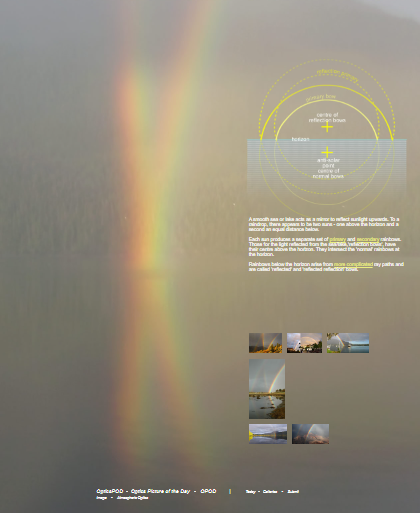OPOD - Reflection Rainbows
OPOD - Reflection Rainbows: A Phenomenon of Nature's Mirror
Rainbows have long captivated the human imagination with their ethereal beauty and vibrant colors. Most of us are familiar with the traditional rainbow that appears in the sky after a rain shower. However, there is another type of rainbow that occurs under unique circumstances - the reflection rainbow. In this article, we will delve into the fascinating world of reflection rainbows and explore their mesmerizing properties.
When we think of a rainbow, we often picture it arcing across the sky. But what if I told you that rainbows can also be seen below the horizon? This is precisely what happens with reflection rainbows. When sunlight falls on a smooth sea or lake, it acts as a mirror, reflecting the light upwards. To a raindrop suspended in the air, there now appear to be two suns - one above the horizon and another below it.
These two suns produce separate sets of rainbows, known as primary and secondary rainbows. The rainbows formed by the light reflected from the sea or lake are aptly named "reflection bows." Unlike traditional rainbows, the center of these reflection bows lies above the horizon. As a result, they intersect with the normal rainbows at the horizon, creating a mesmerizing visual spectacle.
However, the phenomenon of reflection rainbows doesn't stop there. Rainbows can also be observed below the horizon through more intricate ray paths. These rainbows are referred to as "reflected" and "reflected reflection" bows. The intricate interplay between light rays and water droplets creates an intricate dance of colors, further enhancing the beauty of these reflection phenomena.
The study of reflection rainbows offers valuable insights into the physics of light and its interaction with water droplets. By understanding the intricate mechanisms behind these optical phenomena, scientists can gain a deeper understanding of atmospheric optics as a whole. Moreover, reflection rainbows serve as a reminder of the awe-inspiring beauty that can be found in nature's most subtle details.
While reflection rainbows are a relatively rare sight, they can be observed under specific conditions. A calm and smooth body of water is crucial for the formation of these unique rainbows. Additionally, the angle of the sunlight plays a significant role in determining the visibility of reflection bows. When the sun is low on the horizon, the chances of witnessing these mesmerizing phenomena increase.
The exploration of reflection rainbows is not limited to scientific research alone. These optical wonders have also captured the attention of photographers and artists worldwide. The unique interplay of light and water provides an excellent opportunity for creative expression and artistic interpretation. From capturing the vibrant hues of a reflection rainbow to exploring the intricate patterns formed by light and water, artists have found inspiration in these natural wonders.
In conclusion, reflection rainbows offer a captivating glimpse into the intricate world of atmospheric optics. These unique optical phenomena, formed by the reflection of sunlight on a calm body of water, create a stunning visual spectacle both above and below the horizon. By understanding the underlying physics and appreciating the artistic beauty they possess, we can gain a deeper appreciation for the wonders that surround us in nature. So, keep your eyes peeled and your camera ready - you never know when you might witness the enchanting dance of colors that is a reflection rainbow.

Reflection Bows
Imaged by Edward Liske from a ferry on route Bellingham, WA to Ketchikan, Alaska.
©Edward Liske, shown with permission.

A smooth sea or lake acts as a mirror to reflect sunlight upwards. To a raindrop, there appears to be two suns - one above the horizon and a second an equal distance below.
Each sun produces a separate set of primary and secondary rainbows. Those for the light reflected from the sea/lake,'reflection bows', have their centre above the horizon. They intersect the 'normal' rainbows at the horizon.
Rainbows below the horizon arise from more complicated ray paths and are called 'reflected' and 'reflected reflection' bows.
Note: this article has been automatically converted from the old site and may not appear as intended. You can find the original article here.
Reference Atmospheric Optics
If you use any of the definitions, information, or data presented on Atmospheric Optics, please copy the link or reference below to properly credit us as the reference source. Thank you!
-
<a href="https://atoptics.co.uk/blog/opod-reflection-rainbows/">OPOD - Reflection Rainbows</a>
-
"OPOD - Reflection Rainbows". Atmospheric Optics. Accessed on November 26, 2024. https://atoptics.co.uk/blog/opod-reflection-rainbows/.
-
"OPOD - Reflection Rainbows". Atmospheric Optics, https://atoptics.co.uk/blog/opod-reflection-rainbows/. Accessed 26 November, 2024
-
OPOD - Reflection Rainbows. Atmospheric Optics. Retrieved from https://atoptics.co.uk/blog/opod-reflection-rainbows/.